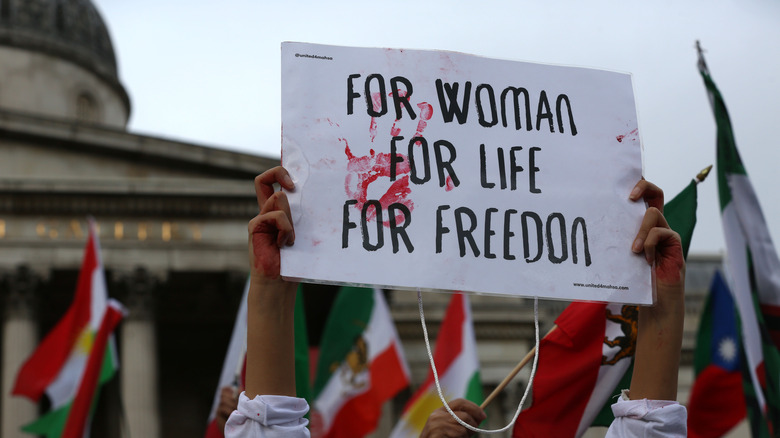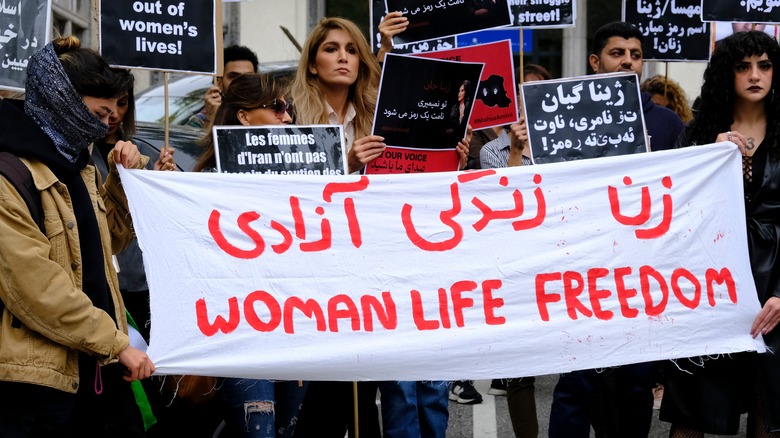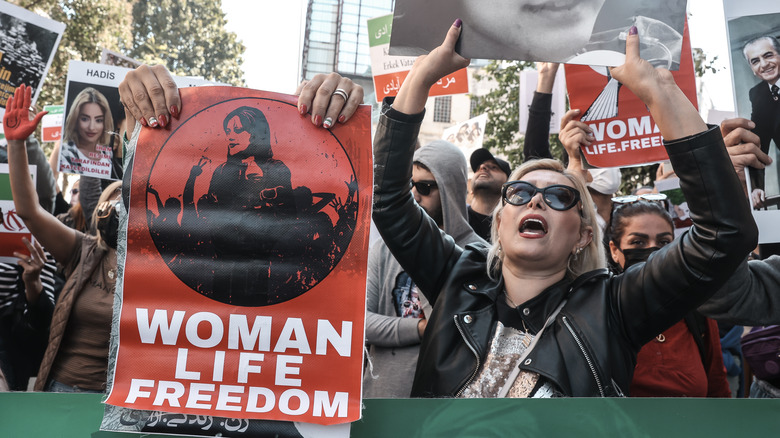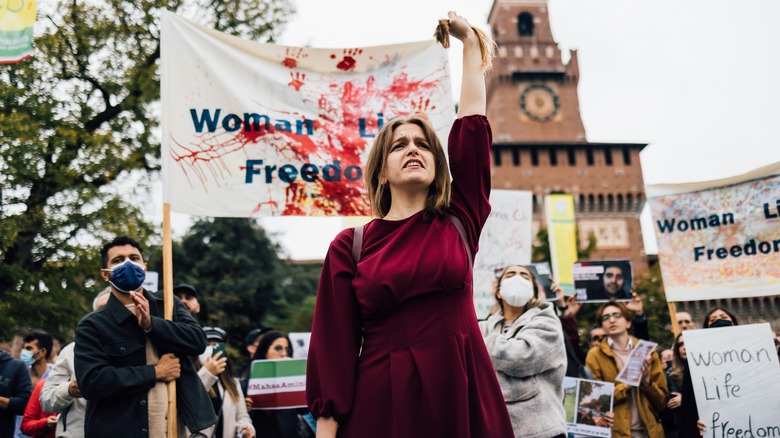The 3 Words That Are Trending On TikTok Amid Protests In Iran
On October 29, Hussein Salami — head of Iran's Revolutionary Guards — warned Iran's youth that he would not allow their protests to continue. "Today is the last day of the riots," CNN reports Salami told protesters. Iranian security forces have been trying (and failing) to quell protests that broke out following the death of Mahsa Amini on September 16. Amini was only 22 when she was arrested for wearing her hijab improperly, The Guardian explains. She died three days later.
Human rights groups have been reporting universities and social media are as much of a battleground for protestors as the streets have been. According to a recent report by the Human Rights Activists News Agency, protests have broken out on over 130 campuses as of November 2, resulting in the arrests of nearly 400 students.
Despite the fact that social media apps are banned in Iran, protest chants are turning into viral hashtags thanks to footage of demonstrations being shared online (per Foreign Policy). On TikTok, a social media app technically banned in Iran, the #mahsaamini hashtag alone has 1.4 billion views. On November 3, BBC Persia correspondent Rana Rahimpour shared footage of women chanting "Death to the Dictator" — another rallying cry popular among Gen Z protestors (via The Problem With).
"Women. Life. Freedom." has also been heard across Iranian campuses this week — another chant-turned-hashtag that has long been associated with the Kurdish women's rights movement.
The women of Gen Z are at the front of the protests in Iran
Hussein Salami's order last week came after protests gained renewed strength on October 26 — 40 days after Amini's death in observance of Arba'een, which NPR explains is a Shiite Islam custom. But according to The Washington Post, protests continued across Iran's universities, filling social media with first-hand footage of the demonstrations.
At the front of this latest evolution of Iran's women's rights movement are Mahsa Amini's peers: the girls and women of Iran's Gen Z. PBS NewsHour reports that this leaderless, "mostly nonviolent" movement is being fueled by female students, many of whom have been burning their hijabs as a protest statement.
Universities have long been a battleground for women's rights and the pro-democracy movement in Iran. In 2009, Iranians, led by university students and numbering in the millions, filled the streets demanding political reforms. The Iranian government's response was to limit not just the number of women who could attend university, but also the subjects they're allowed to study (via the Washington Post).
But according to Manijeh Moradian, a professor at Barnard College, this generation's protests aren't about reform. She told The Post that Gen Z is "rejecting the Islamic republic as a failed experiment." When PBS NewsHour asked what protestors wanted, one student told them they want a regime change before quoting a familiar chant: "Woman. Life. Freedom."
The Kurdish roots of Woman. Life. Freedom.
"Woman. Life. Freedom." is as popular of a protest slogan on social media as it is on the streets. On October 26, Mahsa Amini's picture and the phrase "Woman. Life. Freedom" lit up Times Square and at the time of the writing of this article, #womanlifefreedom has 18 million views on TikTok.
This universal slogan for women's struggle is more than "just words," Elif Saican, an activist in the Kurdish women's movement, told NPR. "Woman. Life. Freedom" actually has its roots in the writings of Abdullah Ocalan — co-founder of the Kurdistan Workers' Party (PKK), which the State Department classifies as a terrorist organization — who Sarican explains believed "a country can't be free unless the women are free." The chant gained mainstream popularity in Turkey in 2009 during the country's International Women's Day march, per NPR.
But in the decades since the slogan has been a rallying cry, what women are willing to gamble has shifted. "Let's be honest, this is a gender apartheid that the regime has imposed on women for over 40 years," Yeganeh Rezaian, an Iranian-born reporter and senior researcher for the Committee to Protect Journalists, told Harper's Bazaar. Rezaian says that for Gen Z, their lives are worth sacrificing if it means ensuring women are no longer second-class citizens in their home country.
What makes Gen Z different
If you're wondering what Gen Z is, we'll clarify: also called "Zoomers," Gen Z encompasses anyone born between 1997 and 2012 (via New Yorker). Protesting against the status quo is a fundamental aspect of this generation's DNA. Forough Alaei, a lawyer-turned-photojournalist, explained to the New Yorker that even before Mahsa Aimi was killed, Zoomers would bind their chests and wear fake facial hair, dressing like men just to sneak into soccer games.
"Generation Z sees itself in a dystopian atmosphere," sociologist Maghsoud Farastkhah told Donyaye Eqtesad. Naz Riahi, an Iranian-born writer, adds that without past nostalgia to live off of, the only Iran Gen Z knows is a "bleak" one (via Harper's Bazaar). With increased access to the internet, this generation has been able to see the way they could be living their lives — if only Iran's current regime was open to reform.
Holly Dangres, author of the "Iranians on #SocialMedia" report, thinks Gen Z is a "force to be reckoned with" when it comes to the protests in Iran (via Al Jazeera). Armed with knowledge and tools to circumvent Iran's internet crackdown, Dangres writes for Foreign Policy that this new generation of Iranian protesters is risking everything to tell the world what's happening in Iran in real time; Human Rights Activists in Iran report security forces have killed at least 287 protestors and as of October 31, the average age of the victims they've been able to identify is 23.



